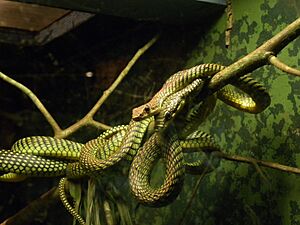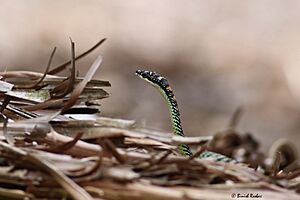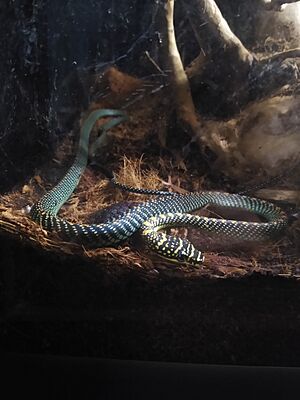Paradise flying snake facts for kids
Quick facts for kids Paradise flying snake |
|
|---|---|
 |
|
| Conservation status | |
| Scientific classification | |
| Genus: |
Chrysopelea
|
| Species: |
paradisi
|
The Paradise flying snake (Chrysopelea paradisi) is a special kind of snake found in Southeast Asia. It's also known as the Paradise tree snake. This amazing snake can actually glide through the air! It does this by flattening its body using its ribs, which helps it catch the air like a parachute.
These snakes usually live in wet forests. When they jump from the top of a tree, they can glide for more than 10 meters (about 33 feet)! Videos show that while they glide, their body wiggles in the air, but their head stays pretty steady. This means they can control where they are going.
Paradise flying snakes are only a little bit venomous, and their fangs are at the back of their mouth. They also squeeze their prey, like lizards and bats, to catch them.
How They Fly So Well
Flying snakes have a very special way of moving through the air. It's different from how birds or other gliding animals fly because snakes are long and don't have wings or legs. Even though you can't see anything special on their body that helps them glide, scientists have studied three main things that make them great flyers.
First, they have a unique way of taking off. They often use something called an "anchored J-loop take-off." This means they hang from a branch in a 'J' shape and then push off to launch themselves.
Second, once they are in the air, their body changes shape. Instead of being round, their body flattens out and becomes shaped like a triangle. This flat, triangular shape helps them lift and glide through the air.
Third, while they are gliding, their body wiggles and waves in the air. This movement, called "aerial undulation," helps them travel even further and control their flight.
Where They Live
The Paradise flying snake lives in many parts of Asia. You can find them in countries like Thailand, Cambodia, Indonesia (including islands like Java and Sumatra), Brunei, India (especially the Andaman Islands), Malaysia, Myanmar, the Philippines, and Singapore.
There are also different types, or "races," of this snake found in specific areas. For example, one type called celebensis lives in Sulawesi, Indonesia. Another type called variabilis is found in the Philippine Islands.
Images for kids







